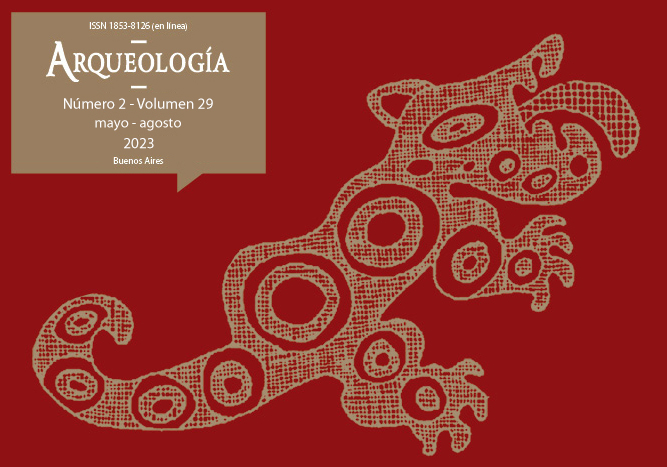La persona desde los adornos en Aguada: entre la Integración Regional y la particularidad espacio-temporal
Abstract
Downloads
References
Callegari, A. (2006). La complejidad social, el paisaje construido y los ritos de convalidación del poder en “La Cuestecilla” La Rioja (Depto. de Famatina). En Actas de la IV Mesa Redonda La Cultura de La Aguada y su Dispersión (pp. 137-150). San Pedro de Atacama: Instituto de Investigaciones Arqueológicas y Museo San Pedro de Atacama, Universidad Católica del Norte.
Cimino, A. O. (2007). Arqueomalacología en las Sierras de la vida: análisis de los adornos realizados sobre materia prima malacológica hallados en el sitio Chenque 1 (P.N.L.C., Pcia. de La Pampa.). En C. Bayón, A. Pupio, M. I. González, N. Flegenheimer y M. Frére (Eds.), Arqueología en las pampas (pp. 309-324). Buenos Aires: Sociedad Argentina de Antropología.
Bourdieu, P. (2007). El Sentido Práctico. Buenos Aires: Siglo XXI Editores.
Fowler, C. (2004). The Archaeology of Personhood: An Anthropological Approach. Oxford: Routledge, Taylor & Francis Group.
Gordillo, I. (2004). El sitio ceremonial de La Rinconada. Organización socioespacial y religión en Ambato, Catamarca. (Tesis de Doctorado inédita), Universidad de Buenos Aires, Argentina.
Hartzell, L. (1991). Archaeological Evidence for Stages of Manufacture of Olivella Shell Beads in California. Journal of California and Great Basin Anthropology, 13(1), 29-39. https://www.jstor.org/stable/27825437 (Acceso: 30 de abril, 2023)
Meskell, L. (2004). Object Worlds in Ancient Egypt Material Biographies Past and Present. Oxford: Routledge, Taylor & Francis Group.
Miller, D. (2005). Materiality: An Introducction. En: D. Miller (Ed), Materiality (pp. 1-50). Durham y Londres: Duke University Press.
Nielsen, A. (1995). Architectural Performance and the Reproduction of Social Power. En: Skibo J., W. Walker y A. Nielsen (Eds.), Expanding Archaeology (pp. 73-90). Salt Lake City: University of Utah Press.
Prieto, C. 2015. La Personhood en Aguada, una mirada desde el sitio de La Rinconada (Depto. de Ambato, Catamarca). (Tesis de Licenciatura inédita), Universidad de Buenos Aires, Argentina.
Rodríguez-Hidalgo, A., Canals, A., Saladié, P., García, A. B. y García, M. (2010). Upper Paleolithic ornament seashells from Sala de las Chimeneas, Maltravieso cave (Cáceres, Spain). Munibe. Suplemento - Gehigarria, 31, 36-46.
Taborin, Y. (2004). El adorno: lenguaje del cuerpo. En: La materia del lenguaje prehistórico. El arte mueble paleolítico de Cantabria en su contexto (pp.151-160). Paris, Université Paris l. Institut d ́Art et d ́Archéologie.
Vanhaeren, M. y F. d´Errico. (2006). Aurignacian ethno-linguistic geography of Europe revealed by personal ornaments. Journal of Archaeological Science, 33(8), 1105-1128. https://doi.org/10.1016/j.jas.2005.11.017
Vaquer, J. M. (2011). Paisaje, materialidad y prácticas sociales en Cruz Vinto. Una interpretación desde los espacios domésticos externos. Saarbrücken: Editorial Académica Española.
Vilas, L. (2018). El cuerpo presentado y representado. Análisis preliminar de figurinas cerámicas antropomorfas del Departamento de Tinogasta (Catamarca, Argentina). (Tesis de Licenciatura inédita), Facultad de Filosofía y Letras, Universidad de Buenos Aires.
Copyright (c) 2023 Carolina Prieto

This work is licensed under a Creative Commons Attribution-NonCommercial-ShareAlike 4.0 International License.
Authors who publish in this journal agree to the following conditions:
- Authors retain copyright and yield to the journal right of first publication with the work registered with attribution license Creative Commons, which allows third parties to use the published always mentioning the authorship of the work and first publication in this magazine.
- Authors can make other independent and additional contractual arrangements for the non-exclusive distribution of the version of the article published in this issue (p. Eg., Inclusion in an institutional repository or publish it in a book), provided that clearly indicate that the work was published for the first time in this magazine.
- It allows and encourages the author / s to publish their work online (eg institutional or personal pages) before and during the process of revision and publication, as it can lead to productive exchanges and greater and more rapid dissemination of work published (See The Effect of Open Access).





(1)13.png)






1.jpg)
1.jpg)


13.png)
1.png)


(1)1.png)









